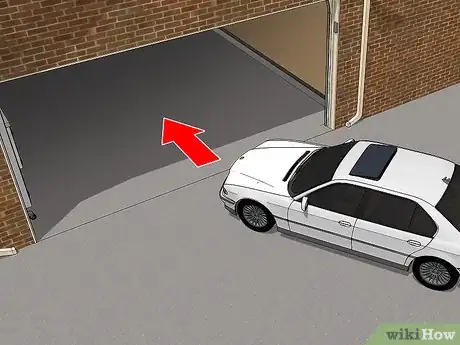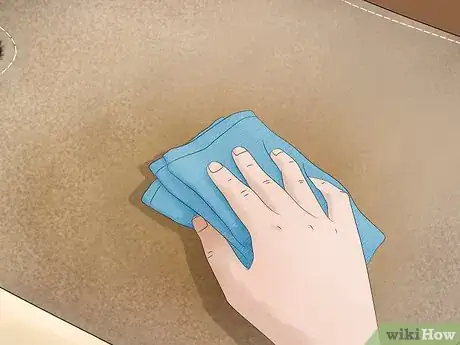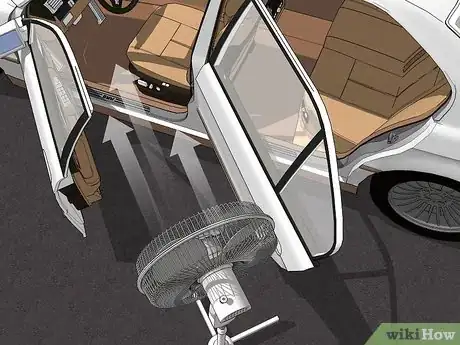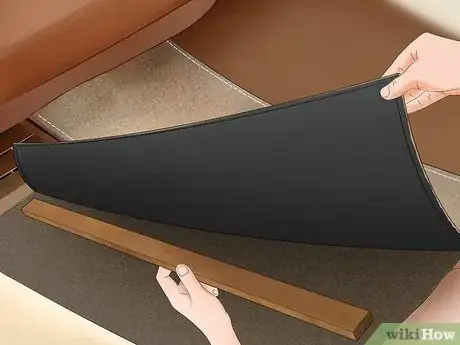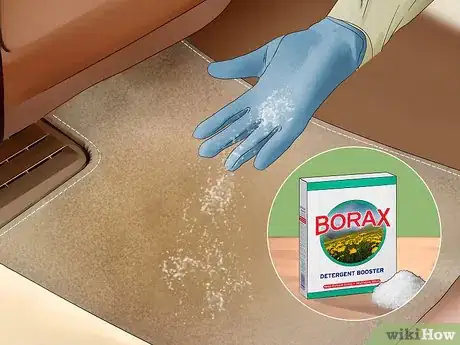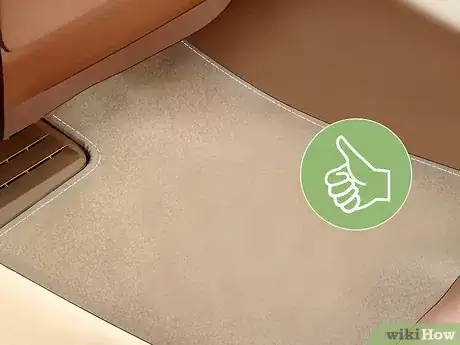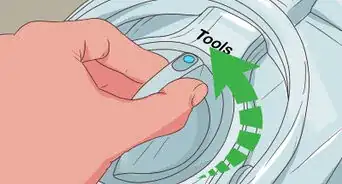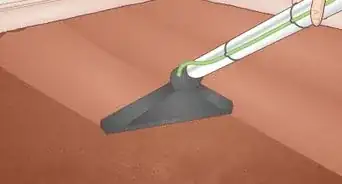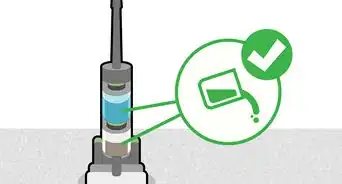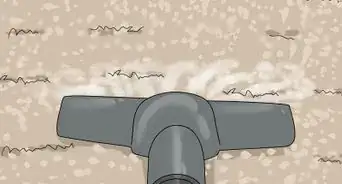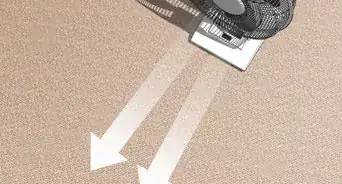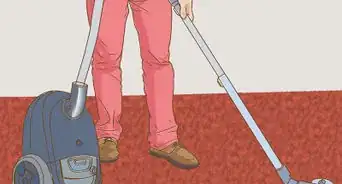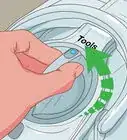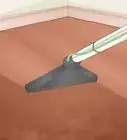This article was co-authored by wikiHow Staff. Our trained team of editors and researchers validate articles for accuracy and comprehensiveness. wikiHow's Content Management Team carefully monitors the work from our editorial staff to ensure that each article is backed by trusted research and meets our high quality standards.
There are 10 references cited in this article, which can be found at the bottom of the page.
This article has been viewed 148,547 times.
Learn more...
Driving through high flood waters or leaving a car door open while it rains can cause the interior of your car to get wet, especially the carpet and floors. To keep mildew from growing on and underneath it, lift up the carpet, use towels and a shop vac to remove the excess water, and run some fans in your car to help evaporate all the moisture out. Afterwards, you may need to use some moisture reducing products to get any remaining water out of your car.
Steps
Getting Rid of Excess Moisture
-
1Bring your car into a garage or covered area to keep it dry. Leave your car windows or doors open in an enclosed space to help moisture evaporate. If the weather’s cleared up and there’s enough sunshine, you can also dry your car out in the sun.[1]
- Be sure you’re drying your car in a secure location so no one can steal anything (or the car itself) while you leave it open to dry.
- Alternatively, if you can’t dry your car someplace safe, keeping the windows and doors shut while running the AC will help to suck moisture out of the car.
-
2Sop up pooling water with a microfiber towel. Microfiber is a synthetic material that certain towels are made of that absorbs larger amounts of water than natural fiber towels. Using one of these, pat down the area where the water is, firmly pressing down your hand to soak it up. Unfold and refold it to use the other side of the towel, and ring it out when it’s completely soaked before continuing to pat dry. [2]
- If you need to move your car and your seat has gotten wet, place towels on it to avoid getting yourself wet when you’re sitting down.
Advertisement -
3Vacuum in your car with a wet/dry shop vac to suck up excess moisture. A shop vac is a special type of vacuum used to clean up liquid spills. Turn the dial on it to “wet” before you begin to suck anything up. Rake the vacuum’s hose over the seat, carpet, and any and all surfaces that have gotten wet. Pay special attention to dry out the electronics and buttons around the interior, especially the ones on the door such as the window control buttons, or the car door speaker.[3]
- If you don’t have a shop vac, check with an appliance or hardware store to see if they rent them out for use.
Evaporating the Rest of the Moisture
-
1Put a fan in your car to generate airflow and evaporate moisture. Place a window unit or standup model fan either in the open car door or right beside it. Allow it to run continuously for at least 2 days, or until the water in your carpet has evaporated. Check it frequently to see the progress of it drying, and move the fan around to have it hit other damp spots after one area has dried considerably.[4]
- A dehumidifier will also work well in the place of a fan, or speed up the process if used in conjunction with one.[5]
-
2Lift the carpet from its sill by the door to help dry the foam underneath. When car carpet gets wet, the water seeps down underneath it to the foam backing, which can grow mildew on it if it stays wet. Use a tool such as a screwdriver to create leverage under the sill to prop it up. Use something firm, like a brick or wooden plank to hold it open and create an air pocket. Towel up the excess water underneath the carpet, and then run a fan or dehumidifier next to it to remove all the remaining moisture. It can take multiple days of running the fan under the carpet to completely dry out the foam.[6]
-
3Hang Damp Rid bags inside your car to remove any remaining moisture. These bags suck up the moisture in the areas they’re placed, so hang some from the handles above the car doors, your rearview mirror, or the headrest of the seats. If you can’t find Damp Rid bags, place some open boxes of baking soda around your car to achieve the same effect.[9]
- Pour the baking soda in a separate container to prevent spilling it.
- You can also place socks filled with cat litter or uncooked rice on top of the carpet to help suck up some moisture.[10]
Deodorizing and Preventing Mildew Growth
-
1Use a vinegar and water solution to clean mildew out of your carpet. Spray the solution and let it sit for 20 minutes. Once it’s done soaking, scrub it with a brush and then dry it up with a towel or shop vac. Repeat the process until the mildew smell begins to lessen in your car.[11]
- You can also use regular dishwashing soap instead of vinegar, or even a tea tree oil and water mixture. Use 10-20 drops of tea tree oil in a spray bottle with water for a solution. Do a patch test on your carpet before cleaning with it to make sure it won’t stain.[12]
-
2Sprinkle borax on any remaining mildew spots in the carpet. Lay down the borax directly on a mildew stain and let it sit for around 10 minutes. Vacuum up the borax, and repeat laying down more if the stain still remains.[13]
- Borax is a safe solution to use on any surface of your car. Just make sure you vacuum up any you sprinkle around to clean.
-
3Make sure everything is dry before putting the sill down or the seats back. Check every surface that was damp to make sure it’s adequately dry before you begin reassembling your car. The foam backing under the carpet needs to be 100% dry, or mildew can still easily grow there.[14]
- If you’re still smelling mildew, check to see if there isn’t a damp spot you missed.
Warning
- Although the interior of a car can sustain a good amount of water damage, take precautions to avoid the engine getting wet, which can completely ruin it if it happens.[15]
Things You’ll Need
- Microfiber towels
- A fan
- A wet/dry shop vac
- Damp Rid bags, baking soda, rice, or kitty litter
- Vinegar and water
- Borax
References
- ↑ https://www.twotwentyone.net/how-to-dry-a-rained-in-car/
- ↑ https://www.twotwentyone.net/how-to-dry-a-rained-in-car/
- ↑ https://www.twotwentyone.net/how-to-dry-a-rained-in-car/
- ↑ https://www.twotwentyone.net/how-to-dry-a-rained-in-car/
- ↑ https://www.autoguide.com/auto-news/2016/11/have-mold-in-your-car-here-s-how-to-get-rid-of-it.html
- ↑ https://www.youtube.com/watch?v=qMufA-LolfU&feature=youtu.be&t=56
- ↑ https://www.youtube.com/watch?v=l6uYeXkLc80&feature=youtu.be&t=30
- ↑ https://www.youtube.com/watch?v=qMufA-LolfU&feature=youtu.be&t=104
- ↑ https://www.twotwentyone.net/how-to-dry-a-rained-in-car/
- ↑ https://www.autoguide.com/auto-news/2016/11/have-mold-in-your-car-here-s-how-to-get-rid-of-it.html
- ↑ https://www.autoguide.com/auto-news/2016/11/have-mold-in-your-car-here-s-how-to-get-rid-of-it.html
- ↑ https://www.getgreenbewell.com/how-to-clean-mold-in-a-car/
- ↑ https://wheelsguide.net/remove-mold-car-seats-interior/
- ↑ https://wheelsguide.net/remove-mold-car-seats-interior/
- ↑ https://www.youtube.com/watch?v=qMufA-LolfU&feature=youtu.be&t=19
About This Article
To dry car carpet, you'll need to get rid of any standing water, then use towels and fans to get rid of any excess moisture. First, sop up any pooling water with a microfiber towel. Then, if you have one, use a wet/dry vac to suck up any excess water. To evaporate the rest of the moisture, open all the doors, and face a fan towards your car to dry it out. You should do this for at least 2 days. Just make sure to do this in a secure location, like a locked garage, so no one tries to steal anything in your car. You should also prop up any floor mats, so the air can circulate below them. To lean how to prevent mildew with vinegar, read on!
